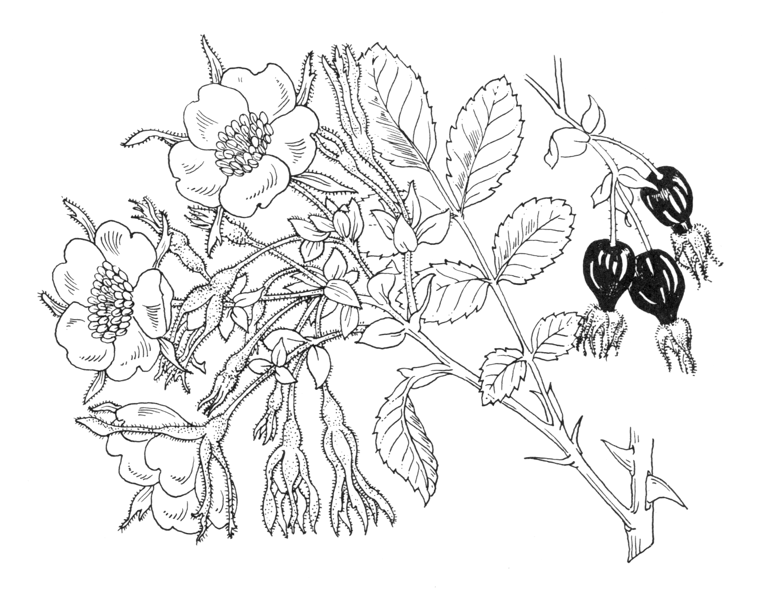A deciduous shrub of loose, spreading habit 6 to 12 ft high; young shoots glabrous, armed (often very strongly) with scattered, straight, or slightly curved spines. Leaves up to 6 in. or more long, composed of five to eleven (usually seven or nine) leaflets which are oval or ovate, pointed, simply toothed, 1⁄3 to 2 in. long, 1⁄4 to 1 in. wide, each pair increasing in size towards the end; dark green and glabrous above, rather glaucous and downy beneath, especially on the midrib and veins; rachis downy, sparsely spiny. Flowers bright rose-pink, 11⁄2 to 2 in. wide, produced during June and July in loose corymbs, each flower on a slender, downy, more or less glandular stalk 1 to 11⁄2 in. long. Sepals 1⁄2 to 3⁄4 in. long, downy, often glandular, ovate at the base but prolonged into an enlarged often spoon-shaped apex. Receptacle glandular and more or less downy. Styles exserted. Fruits pendulous, scarlet-red, bottle-shaped, 3⁄4 in. long, narrowed at the top to a slender neck, above which are the persistent sepals. Bot. Mag., t. 8679.
Native of western and central China, and of S.E. Tibet; introduced by Wilson in 1903 and again in 1908. It is allied to R. macrophylla, but the flowers are usually more numerous in each inflorescence and smaller, the sepals are broad in the lower part and abruptly narrowed to a slender tip and, a difference given by Boulenger, the stylar aperture is narrower, being one-quarter to one-fifth the diameter of the disk, against one-third in R. macrophylla. R. davidii flowers rather later than most of the shrubby species. It is handsomest in autumn, when laden with its pendulous clusters of bright red fruits. As a vigorous shrub of spreading habit it is suitable for the semi-wild part of the garden.
cv. ‘Acicularis’. – Stems densely set with needle-like prickles, which sometimes extend onto the flowering branchlets. Flowers about 1 in. wide, deep rose, borne in June (R. macrophylla var. acicularis Vilm.; R. persetosa Rolfe; R. davidii var. persetosa (Rolfe) Boulenger, nom. illegit.). Raised by Maurice de Vilmorin from seeds sent from Yunnan to his collection at Les Barres and introduced to Britain by Paul of Cheshunt, in whose nursery it flowered in 1912. It is a Chinese counterpart of R. pendulina ‘Malyi’ (q.v.).
var. elongata Rehd. & Wils. – Leaflets longer (to 3 in. long). Flowers fewer in each corymb. This variety is very near to R. macrophylla. See that species for the Forrest introductions identified as R. davidii var. elongata.
R. banksiopsis Bak. – This was described from a plant raised by Miss Willmott from seeds collected by Wilson during his first expedition for the Arnold Arboretum (1907-8). According to Boulenger it represents a form of R. davidii with smooth pedicels. It is not known to be in cultivation.
R. murieliae Rehd. & Wils. – Near to R. davidii, but with grey-green leaves and white flowers. A very elegant species, named after the daughter of E. H. Wilson, who introduced it from W. Szechwan, China, when collecting for Messrs Veitch. It is included in R. davidii by Boulenger.


